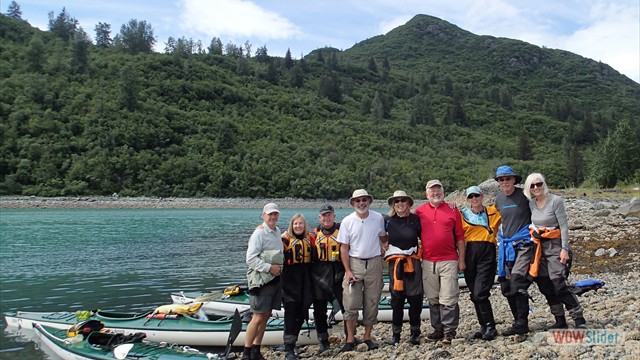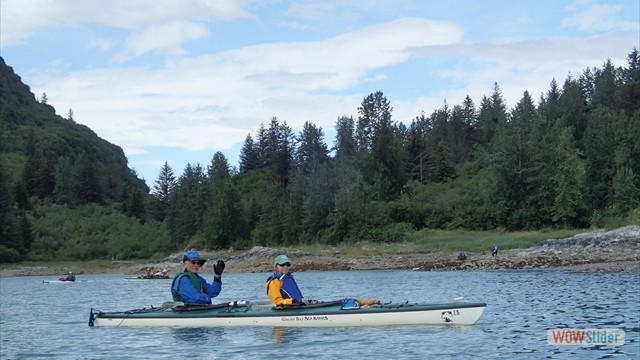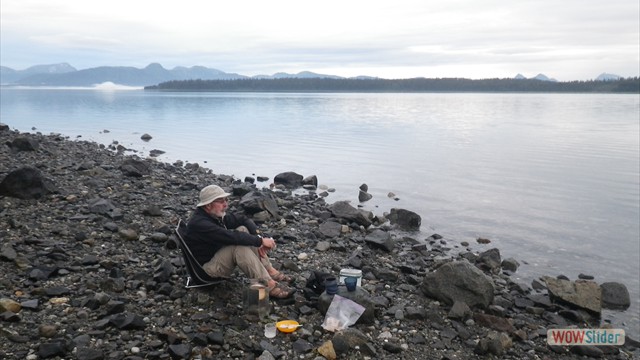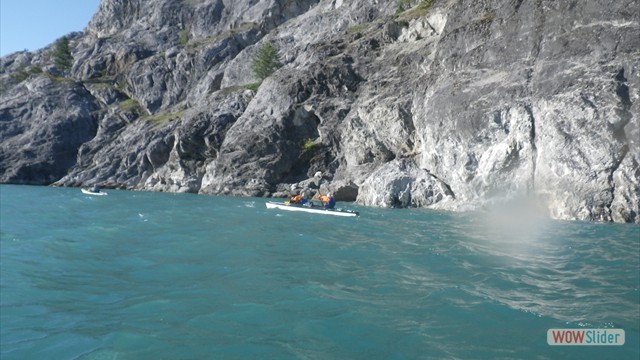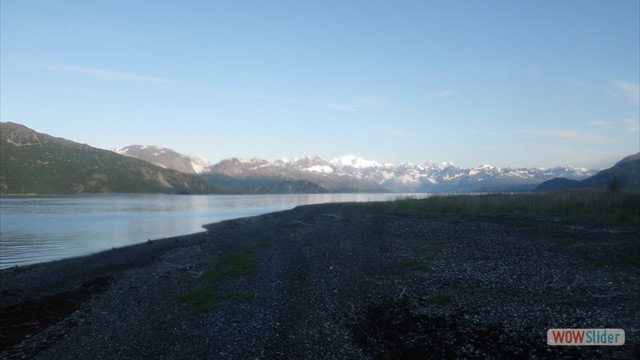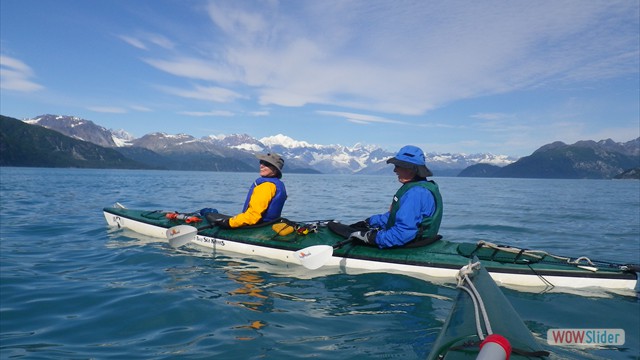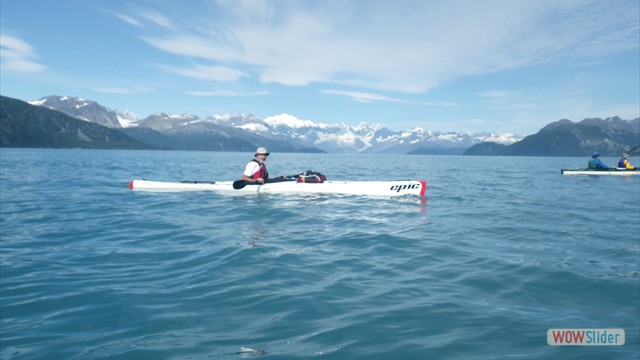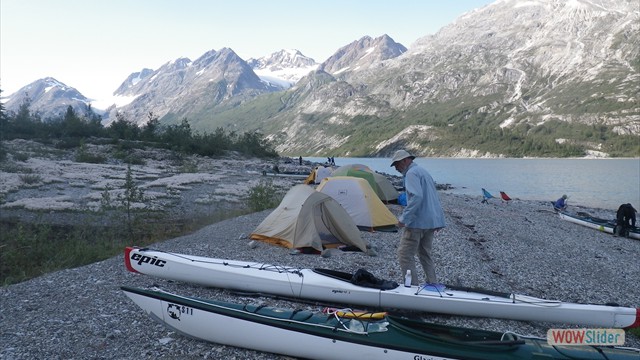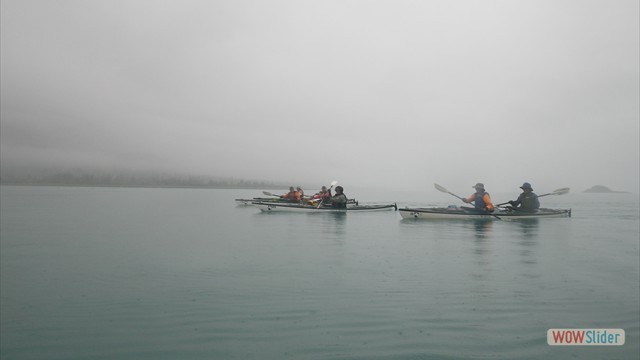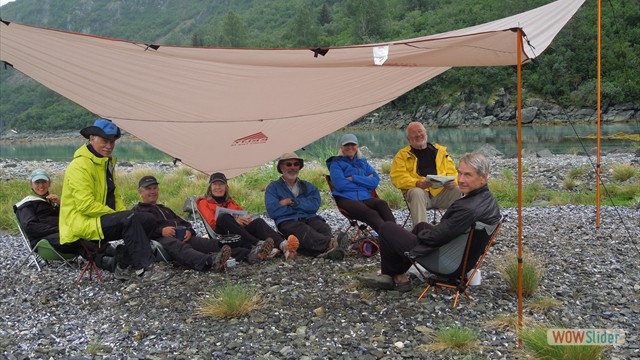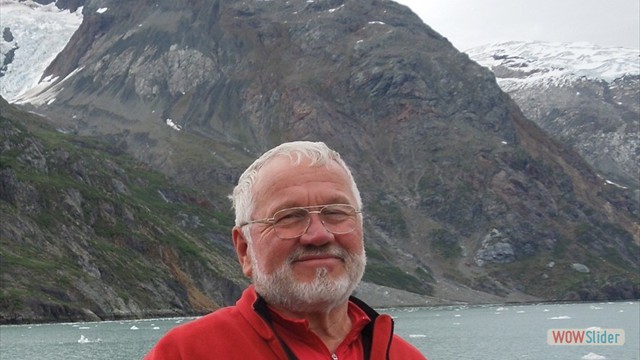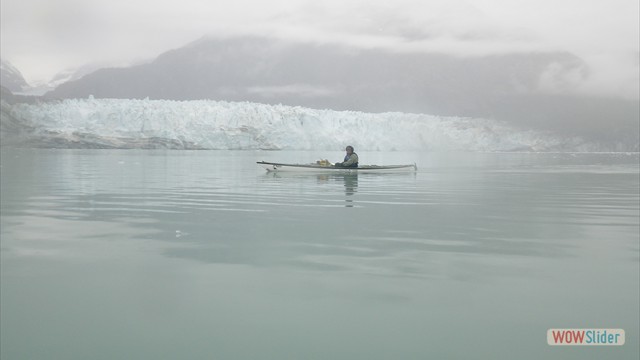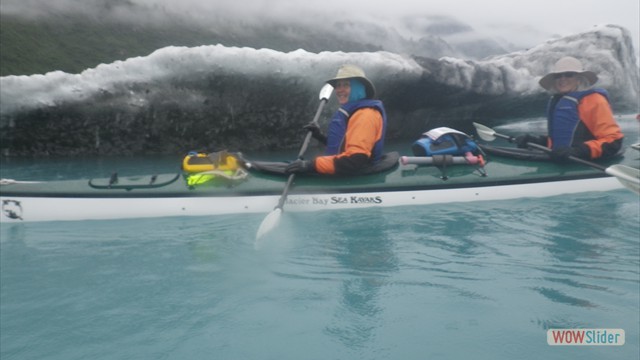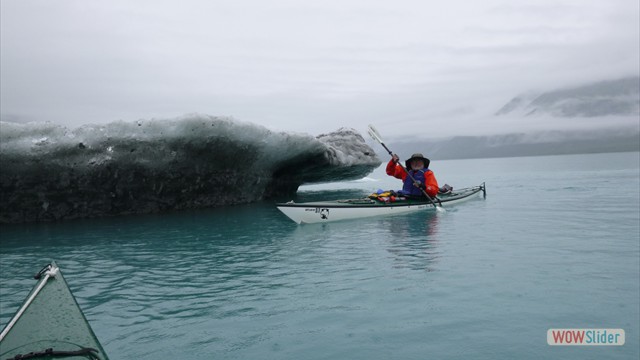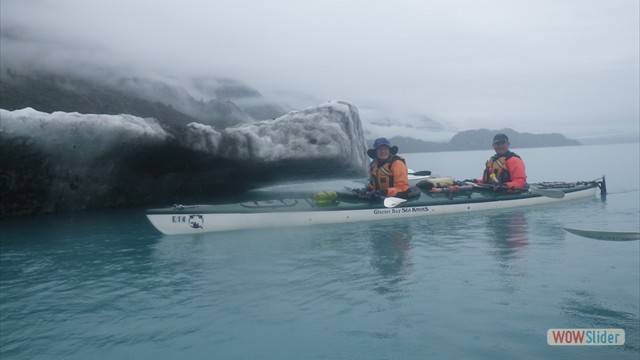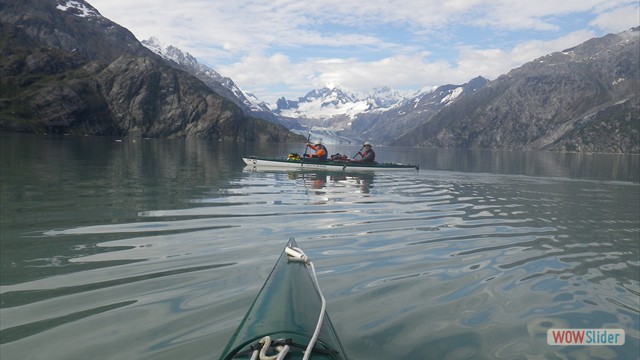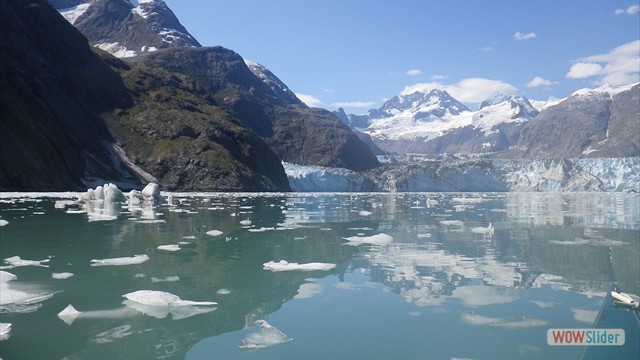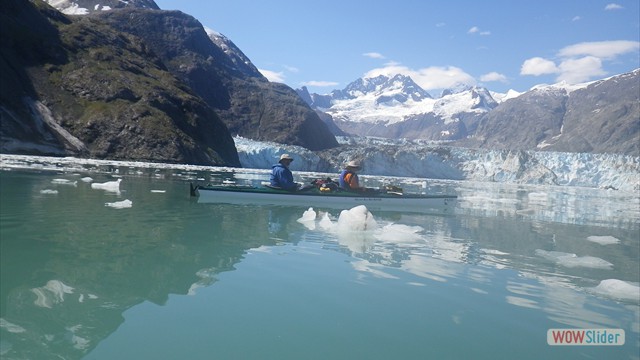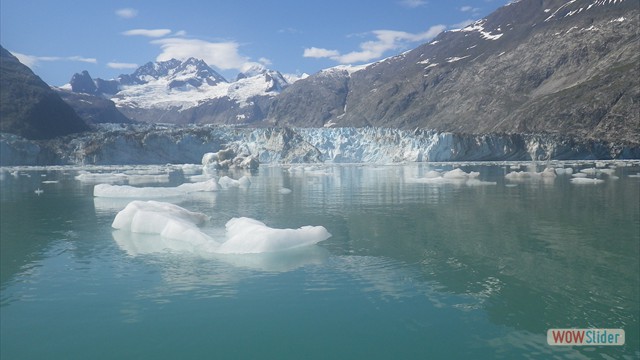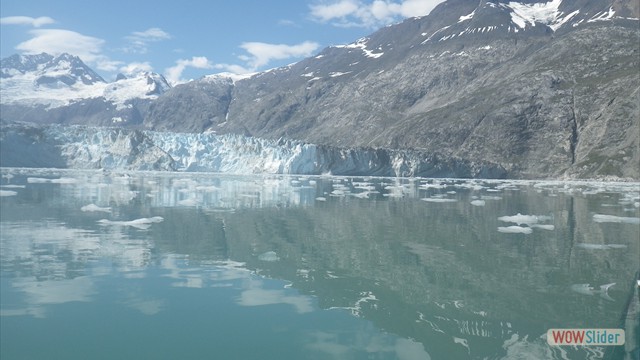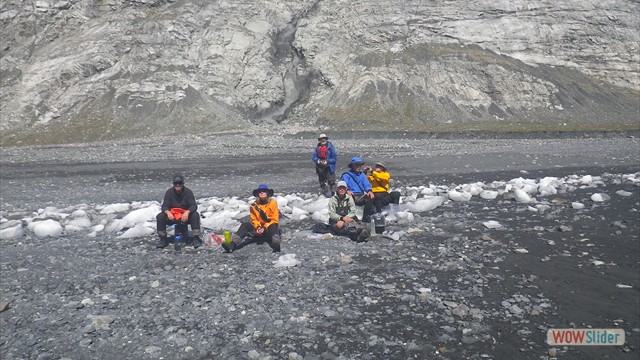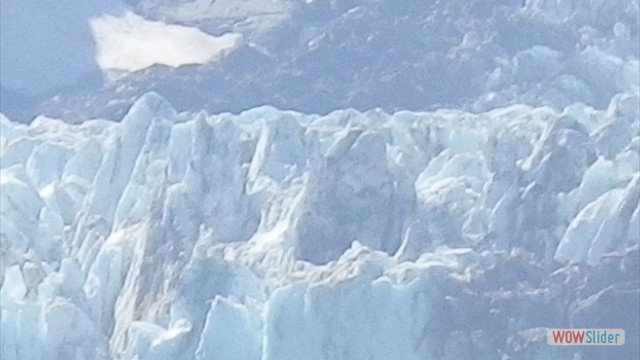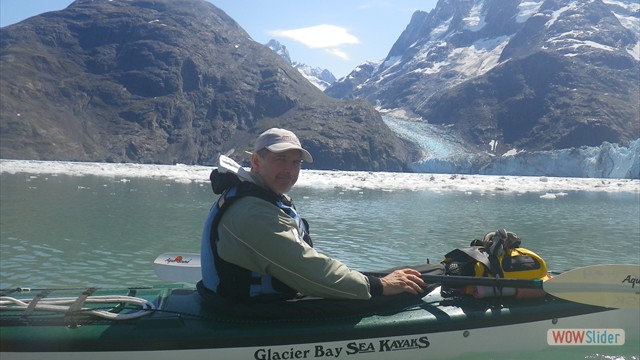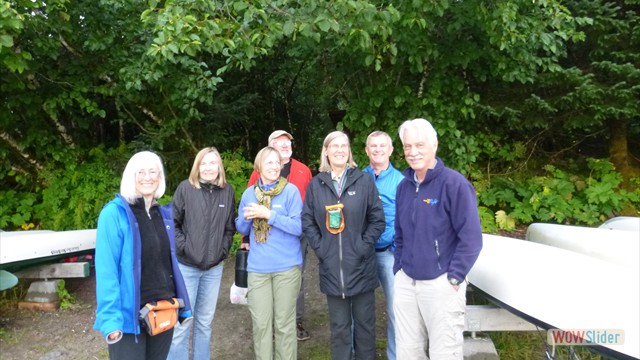|
Special Notes
|
Glacier Bay is a
remote wilderness area, there are no amenities of any kind
once you leave Bartlett Cove.
You will have no cell phone service.
I am recommending the following equipment for this
paddle.
Recommended:
1.
VHF Radio-in case you need
assistance or need weather reports.
Once you get beyond Bartlett Cove your communications
will have to be relayed between other boats in the area.
Getting weather information was problematic during our
paddle.
2.
Dry Suit-I am not a big fan
of dry suits. I
tend to overheat easily in our normal temperatures, but for
Glacier Bay I would strongly recommend them.
We had 3.5 days of rain, the dry suit made it
bearable.
3.
Gloves-when it rained it
was cold. I
strongly recommend good paddling gloves or pogies or both.
I had a fingerless gloves and a full glove, my hands
were very cold with both.
I also recommend a good glove for shore, something
that can handle wet conditions.
4. Rain Gear-take a good rain
jacket and pants for your non-paddling time.
5. Tarps-we had
4 Kelty Noah’s Tarps, these were life
savers. We set
these up first and then set our tents up underneath them,
that way we kept our tents somewhat dry.
We had 3 Noah 12’s and one 16 which we used for a
eating area cover. I don’t go on an overnight paddle without
one in the boat.
The tarp and poles take up very little room in the boat.
Without it you are sitting in the rain or your wet tent.
6. Plan- have a solid
paddling plan and stick to it if you can. Seems like every
time we deviate from the plan - things can get ugly. Have a
discussion with your team about when you go and, more
importantly, when do you abort.
It does no one any good when you think “This is dumb”
but continue to paddle on without saying something.
Stick together or have a plan on rejoining.
Don’t abandon a paddler, keep someone with them,
preferably a strong paddler who can help if trouble arises.
Optional:
7.
SPOT Locator Beacon-We
had one of these in our party.
This allowed us to send our track and an OK message
back to our families. Definitely worth considering for
wilderness trips.
Getting there:
1. To reach Glacier Bay you must fly into Juneau or take the
Alaska Marine Highway Ferry.
Alaska Airlines flies into Juneau and has a
connecting flight into Gustavus.
In June 2015 Delta began flying into Juneau also and
should give Alaska some price competition.
Delta does not fly into Gustavus.
The flight into Gustavus is at 4:25 PM daily during
the summer months.
Flights start in June.
The Glacier Bay Lodge (Bartlett Cove) has a shuttle
bus that takes guests to and from the airport and you can
ride it for free.
2.
You can take the Alaska Marine Highway Ferry from
Bellingham, WA to Juneau, this takes 4.5 days, and the
advantage is that you can take your kayak. The disadvantage
is that you have a 2 day layover in Juneau before catching
the Gustavus ferry, which makes the trip 3 times a week.
From Gustavus, you can take a taxi to the Glacier Bay
Lodge and Campground.
3. Access to the east or west arm of
Glacier Bay is achieved by taking the day boat out to
various drop off points. The cost was approximately $105 for
a one way trip.
There are three authorized drop off/pick up points (Blue
Mouse Cove, Ptarmigan Creek, and Sebree Island).
Using this service saves you a long paddle.
Blue Mouse is 52 miles from Bartlett Cove and Sebree.
The Baronof Wind sails daily from Bartlett Cove at 7:30 AM
and you load kayaks and gear on board at 6:30AM. It took 4
hours to reach the drop off point for Blue Mouse Cove. The
boat traveled to Tarr and Johns Hopkins for sightseeing
before the Blue Mouse drop.
This is a sightseeing boat carrying day passengers
and a naturalist.
Where to Stay:
Rooms are available at Glacier Bay Lodge in
Bartlett Cove.
The lodge has a restaurant and gift shop.
There are a few other local inns available.
Amenities in the area are pretty limited.
The lodge has spotty Wi-Fi service.
The
National Park Service (NPS) has a free campground that is available for
camping. The
campground is about ½ mile from the lodge, ¼ mile from the
NPS office. You
will need a wilderness briefing before you can camp. All
food and other “smell-ables” (tooth paste, deodorant, etc.)
must be kept in the food caches provided and there is no
eating in the campground, you must eat on the beach below
the high tide line.
You can encounter bears in the campground.
NPS does provide free bear canisters for use, both in
the campground and for kayaking or hiking, and they have
wheel barrows to help you get your gear to the campsite.
Showers and laundry facilities are available at the lodge
for a fee.
Weather:
May and June are the “dry” months. There were only a couple of days of
rain in May 2015, June had 7-8 days of rain and July had
many. This area
gets 78 days of sunshine a year - expect it to rain and you
will not be disappointed.
Winds can be an issue, we had 15-20 kt winds our
first day and 10-15 kts on our last day.
Winds flow down the Glacier Bay.
Katabatic winds can develop off the glaciers and will
lower the air temperatures 10-15 degrees locally.
The weather can make this a challenging paddle.
Glacier Information:
|
Glacier
|
Height
Above and Below Waterline
|
Width
|
Length
|
Flow Rate
(in feet)
|
Status
|
|
Grand Pacific
|
60-180 feet above
0-60 feet below
|
2 miles
|
34.5 miles
|
1-4 feet / day
350-1,200 feet / year
|
Slowly
Receding/ Thinning
|
|
Johns Hopkins
|
250 feet above
200 feet below
|
1 mile
|
12.5 miles
|
10-15 feet / day
4,000 feet / year
|
Advancing/ Thickening
|
|
Lamplugh
|
150-180 feet above
10-40 feet below
|
.75 miles
|
16 miles
|
2-3 feet / day
1,200 feet / year
|
Stable to
Receding/ Thinning
|
|
Margerie
|
250 feet above
50-100 feet below
|
1 mile
|
21 miles
|
6-8 feet / day
2,000 feet / year
|
Stable
|
|
McBride
|
200-250 feet above est. 300 feet below
|
.5 miles
|
12 miles
|
15-20 feet / day
5,000-7,000 feet / year*
|
Rapidly Receding
|
|
Muir
|
30 feet above
0 feet below
|
.5 miles
|
12.5 miles
|
.5 feet / day
150 feet / year*
|
Slowly
Receding/ Thinning
|
|
Reid
|
>20-130 feet above
0-10 feet below
|
.75 miles
|
9.5 miles
|
1-3 feet / day
800 feet / year*
|
Slowly
Receding/ Thinning
|
|
Riggs
|
20-90 feet above
0 feet below
|
.75 miles
|
14.5 miles
|
1-2 feet / day
600 feet / year*
|
Slowly
Receding/ Thinning
|
Highlighted Glaciers are in the West Arms
Lessons Learned:
I packed too light. I
should have taken more and warmer clothes.
Thank goodness I bought a dry suit for this trip.
I also had some Kokotat Dry Launch socks that were
great! Kept my
feet and pants leg dry.
Good hand protection is a must while paddling.
Pogies might have worked better.
Good water resistant gloves for on shore would have been nice.
Tarps with poles are a must, and I would recommend the Kelty Noah’s
tarp, light weight and easy to pack.
You want to practice for this camp in the rain in late March/April or
October/November in Puget Sound.
That will tell you where your equipment weaknesses
are.
If you get cold easily, pack accordingly, and only go on this paddle if
you are healthy.
The conditions can even challenge a healthy person.
Add in a lingering injury or illness and it gets a
bit harder.
|
|
Description
|
I arrived 3 days before our paddle and met
our one paddler who took the ferry.
We had a day paddle
planned for the following day.
I received my camping/wilderness orientation and
filled out our back country permit (no fee).
I had rented a kayak from
Glacier Bay Kayaks
and they delivered an Easy Rider Eskimo 17 Kevlar for my
use. The other 7
paddlers rented boats from them also.
We had 3 doubles, all were Easy Rider Belugas.
The Easy Rider boats are very stable boats and do
well as rentals.
I did miss my Nimbus Twelka!
The day of my arrival was the first rainy day.
Day paddle.
I checked out my rental boat and proceeded to set it
up adjusting the foot pegs and getting the seat sorted and
tightened up. The Easy Rider is a good boat, its stable and
it rides through the water well.
The two of us headed out into Bartlett Cove, the plan
was to just paddle around and get comfortable in the kayak.
We ended up paddling 4.5 miles in the cove.
We did see a humpback whale in the cove surface and
then re-submerge about a 1000’ from our boats.
We waited to see where it was heading and after a few
minutes of watching, it suddenly surfaced about 15’ in front
of my boat. A
bit of a surprise and definitely not enough time to grab my
camera. A nice
start to this trip.
We headed back in and stored the boats for Monday’s
departure.
Day 1:
We are up early since we need to pack up our
camp and get all our gear down to the Day Boat.
We used one of the NSP wheel barrows to help us get
all our gear down to the dock.
We staged all of our kayaks the night before and we
are all ready to load them at 6:30.
Loading begins promptly with us working with the crew
to stack all of our kayaks on the bow of the Baranof Wind.
We haul our camping gear in and store it at the back
of the boat. It
will take about 4 hours to get to Blue Mouse since the boat
also carries sightseers to the glaciers prior to dropping us
off. We use the
opportunity to look at our route and scout out potential
camp sites. We are all very excited about getting on the
water.
We arrived in Blue Mouse at about 1:30, we
were fed a nice lunch on board, and have moved all our gear
to the front of the boat for offloading.
The Baranof Wind eases itself onto the beach and we
start the unloading process.
The boat is picking up 2 kayakers who help us
off-load boats and gear and then we help them load their
gear on board.
The weather has turned sunny and there is no rain in the PM.
The fun now begins with trying to fit everything into
the boats. I am
carrying 5 bear canisters since the one Epic on the trip
does not have a hatch big enough to allow loading a bear
canister. We
finally get loaded and get ready to depart Blue Mouse for
Queen Inlet - we have a 12.7 mile paddle planned.
We depart and paddle out of Blue Mouse into the main
channel for crossing only to find a stiff wind of 15-20 kts,
with wind driven waves of 12-18”.
We continue with the crossing, a planned 2.7 miles.
We soon find that we are making little headway, down
to around 1 kt or less at times.
The Easy Rider takes a lot of water over the bow
since it is a very flat bow.
I also find that I have loaded my boat tail heavy
making it much harder to paddle.
This is not a great way to start!
We battle the crossing for over two hours… and end up
getting blown back 2.2 miles from our intended crossing
point. After making it ashore, we pull out and rest. We
decide to abandon the idea of getting to the end of Queen
that day and after an hour rest, we paddle around Gloomy
Knob and plan to camp at the first suitable site.
We see mountain goats on the lower levels of Gloomy
Knob - a nice treat on a rough day.
The wind continues to blow in our faces and the water
is a little calmer with <12” wind waves.
After about an hour of paddling we reach what looks
like a nice beach with a small cove.
We pull ashore and walk it to see if it is suitable.
The site is a good campsite and we unpack and set up
camp. We eat a late dinner on the beach storing our bear
canisters about 75 yds. from the tents.
Everybody is tired and will sleep well tonight.
Total paddle distance 7.1 miles
and it took us 5+ hours!
Day 2:
Some of us rise early and are treated to a
gorgeous sunrise as the sun finally gets above the mountains
east of us. The
sun lights up the Fairweather Range to the west of us, it is
an amazing site.
We have breakfast on the beach and discuss our options: we
decide not to paddle all the way into Queen and instead pick
up our day 2 route into Rendu Inlet.
Once breakfast is done, we start to pack up our
campsite when a bear wanders to within 50 yds of us!
One of our paddlers was on the far side of the bear
and used her air horn to scare the bear… luckily the bear
ignored the air horn, otherwise it would have scared the
bear towards where we were standing. The bear ambled off,
taking care of its needs, leaving us to quickly pack up and
load the boats.
Just before we launch - the bear, or a cousin, reappears
down the beach giving us some urgency to depart.
It is a glorious sunshine day, there is no wind and
the water is flat!
We are soon underway stopping frequently for photo
opportunities.
We paddle along shore toward Queen so that we could at least
get a good look into the inlet.
We come across the Sea Wolf, a kayak mothership, and
stop to see if we could get an updated weather report.
Unfortunately, even with the Sea Wolf’s stronger
radio we can’t get an update.
We continue on, turning north to skirt the east side
of Composite Island. Heading for Rendu, we come across a
couple of river otters playing in the water chasing each
other. Quite a
sight! Checking
out Composite, it looks like there are some potential camp
sites on the north end of the island.
We cross over to Rendu Inlet entrance and find a
beach to pull out at for lunch.
It’s a nice rock which has soaked up the sun’s heat,
making a great place to sit and have lunch.
There are some great looking wild flowers on the
slope above us.
We proceed on after a nice stop, the weather is quite warm,
and we are all enjoying this much better than day one.
About a mile into the inlet, we spy a small waterfall
at water’s edge and opt to land and refill our water bags.
The water is clear and a bit warm.
Talking to other paddlers prior to our departure, we
found that they all drank the local water with no ill
effects, but we are carrying steri-pens and plan to use
them. We continue up the inlet enjoying the steep hills on
both sides with numerous waterfalls.
We start seeing small ice chucks floating down the
inlet. It’s our first encounter with ice.
Two of us paddle all the way to the end of the inlet
to check out Rendu glacier (which is a retreating glacier.)
Conrad decides to test the moraine by walking on it
and soon finds himself sinking 2-4” inches into the fine
silt mud! We soon
turn and paddle down the far side looking for a suitable
camp site. We
pass up our first camp site to look at a better one just ½
mile down. The
beach is good and there is a stream flowing here.
We land and perform a recon. There is bear sign,
belly holes and foot prints, but after discussion we decide
to risk it since pretty much every site we have seen has
bear sign! The
site has a nice natural shelf that we use to place the
tents. We set up
our kitchen as far away as we can across the creek and we
have another nice meal enjoying the sunshine.
Total paddled 16.2 miles, trip total 23.3
miles.
Day 3:
The clouds are back.
The clouds are hanging on the hills and we are hoping
the rain holds off as we eat breakfast and pack our
campsite. We are
treated to a harbor porpoise feeding just off shore as well
as a sea otter or two.
We head out toward Russell Island.
We paddle down the inlet enjoying the views and soon
round the point out of Rendu and head toward Russell island.
We stop for lunch and a potential campsite.
The beach looks good for camping, as usual, but there
are bear signs although we see no recent activity.
The site is about 1.3 miles from the point.
We watch a cruise ship come down the main channel
(west of Russell Island.
There are normally 2 cruise ships a day in the bay.
They are limited to 10 kts speed but still throw up
quite a wake.
The clouds/fog hang in the air but there is no rain.
We continue on after lunch heading over to a series
of small islands just south of Russell Island.
We paddle past them
enjoying the myriad of birds present.
We reach Russell Island and start looking for a
suitable campsite. We
settle on an area adjacent to Russell, connected at low
tide. There is
enough space for our party and we quickly set up camp.
We set up our dinner shelter, the Noah Tarp 16, so
that we’ll have a dry place to sit and eat.
It starts sprinkling not long afterwards and then it
begins to rain hard.
We sit under our tarp and enjoy our meals while
staying dry.
Total paddled 15.2 miles, trip total 38.5
miles
Day 4:
We wake up to low clouds and fog, it is
chilly. We have
breakfast and quickly pack up camp, the rain has let up
considerably. My
tent floor is wet as rain has gotten on top of the
footprint. I use
my towel to get it as dry as possible.
We get all packed up and head for Tarr Inlet, home to
two of the largest glaciers in the park: Margerie and the
Grand Pacific.
As we begin paddling north the rain starts again, it is cold
and wet. I am
glad I invested in a dry suit!
My hands are chilled, I am using NRS neoprene
fingerless gloves, and they provide no warmth in the cold
rain. I switch
to full fingered gloves later, still no warmth.
Everyone is getting chilled and I am concerned for
two of our group that do not have dry suits. We paddle into
Tarr, it is a 16.6 mile paddle to Grand Pacific and a
potential camp site.
Landing opportunities are limited.
The weather stays miserable for the rest of the
paddle. After a
few hours we reach the head of the inlet where the campsite
is indicated to be on the right side of the inlet, but the
river has shifted and we cannot reach our intended
destination. We
stop at a small sliver of a beach across for Margerie for
lunch as we have not eaten yet.
No sooner do we get ashore than we start getting
pounded by waves being generated by ice falls on the
glacier! We
quickly launch our kayaks and get off shore, some of have
our lunches out and quickly eat on the fly.
We break into two groups at this point, one of the
paddlers in a double is extremely chilled and they opt to
head south and find a camp site.
The other group opts to paddle over to Margerie.
I follow the Margerie group since those paddlers
didn’t have dry suits and we wanted to keep a radio with
them. We are
only able to get within ¾ to ½ mile from the glacier when
our way is blocked by ice.
We paddle the face of the Glacier and head south to
catch up with the rest of our gang.
We paddle on and soon catch up with the group.
They have located a
camp site on the west side of Tarr Inlet.
The beach is OK, with some big rocks, but there is
plenty of space for tents.
We quickly get all our Noah’s Tarps up, we use them
to set up our tents beneath and keep them somewhat dry.
We set two tents under each one, except the eating
area, the tarps provide a dry space for accessing the tents.
The group tries to warm up and those who haven’t
eaten get a bite to eat.
This was a miserable day, very wet, very chilly.
That evening we have dinner.
Total paddled 18.4mi, trip total 56.9mi
Day 5:
The rain has turned to mist in the AM, we
eat breakfast and discuss our options.
I am concerned about hypothermia with a couple of our
paddlers, especially if the rain continues.
The temperature is OK as long as you are paddling,
but you cool off quickly just sitting, plus our two without
dry suits are just cold and wet.
We have one team member ready to bail. We start
paddling, heading for Johns Hopkins Inlet.
The good news is that
we will be staying there for 2 days, and we are also close
enough that we can get our team member to Ptarmigan Creek
pick up if we need to.
We paddle south and slowly the clouds begin to lift,
the fog disburses, and the mist stops.
There may be hope.
Today is a short paddle of about 10 miles.
We soon are rounding the corner out of Tarr and into
Johns Hopkins. We start looking for our campsite which is
located about 2.4 miles from the start of the inlet.
The sky continues to brighten and we can almost see
the sun. The
clouds are not very high and I have high hopes for a little
sun in the PM.
We continue up to our campsite when we spot a nice spot just
short of our intended destination.
The beach looks good
and after landing, we verify good tent sites and see that it
is protected on 2 sides from any potential wind.
The beach is OK, if a bit steep.
We quickly get our tarps set up, including our eating
area. The
weather continues to improve and we have sunshine by later
in the afternoon.
We use the opportunity to hang gear up to dry out!
We have a great view of both the Johns Hopkins and Lamplugh
Glaciers. Our spirits improve with the weather and we
enjoy the late afternoon sunshine while having a quiet
dinner. We have
the thundering of both the Johns Hopkins Glacier and Lamplugh
Glaciers calving all night. We have a day paddle planned for
tomorrow - no packing up!
A nice break.
Later in the evening we watch a large male orca swim
down the inlet.
His vertical fin had to be at least 8’!
Quite a sight.
Total paddled 11.5 miles, trip total 68.4
miles
Day 6:
We wake up to sunshine!
The Fairweather Range is all lit up by the morning
sun. Everybody
is feeling better.
Amazing what a little sun and warm temperatures will
do! We have
breakfast and pack our lunches for the paddle to Johns
Hopkins Glacier.
We are soon underway and the sun is on our backs.
We paddle up the south side of the inlet enjoying the
views. We have
large ice floating in the inlet, mountains run right down to
the water with few beaches for landing, and we enjoy all of
the waterfalls along both sides.
We enjoy the paddle west, playing in the ice and the
waterfalls where we can.
We spot a boulder tumbling down the mountain and
watch to see if it will reach the water - luckily it stops
on a shelf about 1500’ up.
The area is still pretty unstable and one needs to
keep an eye out.
We see many bald eagles as we paddle up to the glacier.
After a couple of hours we are about a mile from the
glacier paddling in the ice.
What an unusual sight.
We enjoy ourselves!
The temperature cools off about 5-10 degrees as we
get closer to the glacier.
We see the Baranof Wind coming up and we paddle up to
see if we can get some beer, no luck! But it was fun seeing
the crew that dropped us off.
We decide to take a lunch break on the beach by
Chocolate Falls.
Chocolate Falls is a river that comes down on the north side
of the inlet being fed by Charley Glacier.
This river falls down a steep slope and then has
about a 150-200’ drop at the end of it.
The water is milky brown from all the silt.
We have a nice leisurely lunch and then decide to
explore as close to the glacier as we can get on the north
side. We’re only
able to get about ¾ of a mile before the ice packs up and we
don’t want to take a chance of damaging our boats.
We watch several calving events while we are hanging
out at the glacier.
It is all very impressive.
Too soon it is time to head back down to camp.
We are downwind as we paddle east and with the sun
out, we are soon cooking in our dry suits which entails
several stops to shed layers.
What a difference from 2 days ago!
It was good to get back into camp!
We had a pleasant evening and enjoyed the company and
views. Just
after sunset I had to make one more trip to the water’s edge
and was treated to one of the most beautiful sights I have
ever seen as all of the large peaks at the end of the valley
were bathed in the setting sun, glowing brightly.
It was a breathtaking sight… made the trip worth it
all.
Total paddled 17.5 miles, trip total 85.9
miles
Day 7:
We woke up in the morning to a high layer of
clouds. We had a
nice breakfast and then packed up camp - we have a 13 mile
paddle planned.
We have one paddler still not feeling well who wants to be
dropped at Ptarmigan Creek for pick up by the Baranof.
It is on our route and we can easily reach it before
the boat gets there.
We head out and cross Johns Hopkins Inlet to Lamplugh
Glacier when we see a cruise ship about 5 miles out heading
toward the inlet and increase our pace so that we are clear
of the ship. We stop at a waterfall and replenish our water
and, unfortunately, my 2nd and last water
container is dropped and broken.
The Seattle Sports water keg is not designed for this
environment.
Dromedaries are stronger and better suited to this type of
paddling. We play around in front of Lamplugh which is a
grounded glacier and at low tide is totally exposed.
We land on the north corner and walk around on the
silt just to say we did it!
This is the last of the major glaciers we will see.
Soon we are heading south and there is a potential
camp site just at the south edge of the glacier. We do not
explore the tent sites although we had spotted a couple of
tents there while on the Baronof.
We watch the cruise ship and they watch us… wonder
how many tourist pictures we are in!
We soon leave Lamplugh behind.
It does not take long to reach Ptarmigan Creek.
We have contacted the Baranof to let them know we
have a paddler for pick up and it turns out that there are
quite a few paddlers there waiting for pick up.
We dropped our team member off and repacked a double
so we could send a single back with her.
We then hung out at the beach, waiting for the boat,
hoping to get another crack at acquiring a few beers!
Fate intervened and it started to rain so we decided
to get started for our next campsite.
We head along the shore and reach Reid Inlet, where
there is a nice spit located at the entrance that
looked very good for camping.
This is also the site of two cabins ever build in
the park. The
cabin is mostly gone now, but these early settlers did plant
fruit trees here that are still growing.
Reid Glacier is visible at the end of the bay.
The group has a discussion and we decide to head
on... as we
close in on our intended campsite, a decision is made to
continue. We now
have a steady rain falling.
I do not like getting off plan - it tends to cause
problems down the road.
We continue on to the Skidmore Cut, you can paddle
through this at a 15’ high tide, unfortunately we only have
an 11.3 tide and crossing would involve a portage.
We decide to not make the portage after exploring the
cut. The length
of the cut is about .7 miles and we were able to paddle into
the cut about 500-600’.
We did not explore any further since the high tide,
15’+, would occur at 10:30 PM.
No one wanted to stay up that late.
We ended up at the far south end of the beach by the
cut, it was our worst campsite of the trip.
We quickly got our Kelty’s up and set up our tents.
Our easy 13 miles had ended up being a 17.3 mile
paddle. We had
dinner in the rain with no dinner tarp.
Talk of heading in the following morning was
discussed.
Total paddled 17.3mi, trip total 103.2mi
Day 8:
It was still raining in the AM, so we had
breakfast in the rain and quickly packed up our tents and
gear. We paddled
around the Gilbert Peninsula which has few stopping places
and is usually avoided by the locals because the water can
be rough. We
were no sooner underway when we started encountering 12”
waves off our left quartering bow.
The boats handled it well but it did make paddling a
little more difficult.
About 2 miles into our paddle one of the doubles
broke its rudder blade.
This was a first, and it was also non-repairable. The
doubles continued on picking up their pace, this left the
singles behind.
The Epic struggles in rough water (it does great in flat
water) and with chop its speed quickly falls off.
The two singles paired off and continued on behind
the doubles. The
water continued to get rough and soon the waves were
approaching 2’. Luckily, the wind was not a factor blowing
at about 10 kts, and this
was only a 7.3 mile paddle!
We pounded on through the waves, the Easy Rider did
very well in this water and I was impressed.
Our final challenge was the entry into Blue Mouse
Cove where
the quartering seas turned into a following sea... never
fun, but soon we were far enough inside to be protected from
the waves. The
group decided to head in.
We had two optional days of paddling planned, but
everyone was wet and chilled.
We prepared our boats for pickup, set up our dinner
tent and waited for the boat.
Total paddled 7.3mi, trip total 110.5mi
Conclusion:
This was a great trip and I would encourage
other paddlers to go and see this magnificent wilderness for
themselves. You
need to be prepared with a good paddling plan and good
equipment. I
hope this report would help anyone planning on doing this
paddle to get organized for the trip.
|


